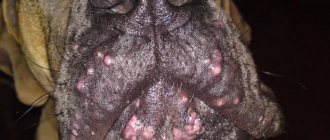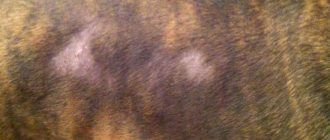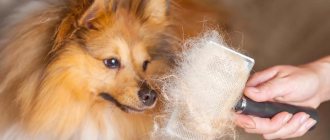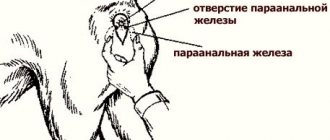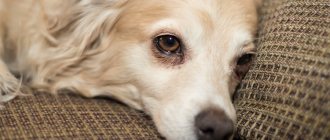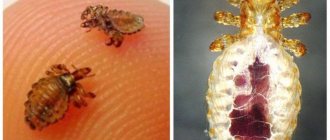Seasonal molting in animals is a sign of normal functioning of the body. Some breeds are characterized by year-round hair loss, while others experience hair loss in the off-season. Non-shedding species have been created that are important to cut and trim. But if the process leaves bald spots and causes itching, then this is a cause for concern: the dog is sick.
Why does a dog's tail go bald?
- The cause of tail baldness is pathology of the sebaceous glands on the pet’s skin. The glands secrete sebum, which nourishes the dog's skin and coat. If sebum is secreted and lubricates the skin and coat, the hair grows smooth and elastic. Sebum plays a protective role. If the sebaceous glands of the skin begin to synthesize an excessive amount of secretion, this can lead to baldness of the tail. Veterinarians call the disorder a mangy tail. In some cases, the disease disappears spontaneously, but more often a secondary infection occurs, promoting the inflammatory process.
- Hair loss of the tail is caused by helminthiasis; fleas become carriers of the disease.
- Endocrinopathies in pets lead to the formation of bald spots on the fur. They can also be caused by excessive adherence to antibiotics.
- The cause of bald spots is lichen, fungal infections, eczema, dermatitis, including allergic ones.
- Lack or excess of vitamins is reflected in the animal’s coat.
Possible causes of the disease
The second name for hair loss is alopecia, and this is normal if the animal does not itch and does not lose activity or appetite. The key to a high-quality coat is proper care of your pet and a balanced diet. But the cause of molting can also be a disease. Therefore, there are two types of prerequisites for the occurrence of non-seasonal molting: hormonal and non-hormonal.
Hormonal imbalances
Hormonal imbalances are associated with dysfunction of the thyroid and sebaceous glands . They occur against the background of other serious diseases (due to decreased immunity, the villi become brittle). Or as a result of sterilization (when the release of the sex hormone is reduced, the animal rapidly gains weight; its skin softens, the condition of the hair follicles worsens; the abundance of undercoat growth decreases).
If the cause of alopecia lies in hormonal imbalances, then the first bald patches appear on the neck and chest. Bald spots are symmetrical and gradually spread throughout the body.
Hypothyroidism
Insufficiency of the thyroid gland. More often, older dogs or overweight dogs are susceptible to this pathology. Spaniels, Dachshunds, Airedale Terriers, Doberman Pins, and Setters are predisposed to the disease.
Symptoms of hypothyroidism include:
- Decreased temperature, activity, lack of interest in life;
- Weakness, poor tolerance to exercise training;
- Rapid weight gain;
- Swelling of the muzzle;
- Disturbance of body pigmentation;
- Hair becomes fragile, brittle, faded;
- Alternate hair loss on the back, chest and neck in clumps.
Treatment is based on the administration of hormones, special tablets to stimulate the glands such as Levothyroxine capsules.
In the photo there is a dog with hypothyroidism
Pituitary dwarfism
Characterized by a lack of growth hormone. This disease is genetic, not acquired, and is observed in a small number of puppies. German Shepherds are more often prone to the disease. The only way to check a puppy's predisposition is with a DNA test. Symptoms appear 3-4 months after birth:
- The baby stops developing and growing.
- He develops problems with his teeth and skin (the skin becomes thin, which increases the risk of irritation and dermatitis).
- In addition, the hairs die and fall out before the seasonal molting. This is explained by the fact that puppy fur does not change to adult fur.
The dog in the photo has pituitary dwarfism
Hyperestrogenism
Estrogen is a female sex hormone. The disease involves an excess of it, both in females and males. Causes of appearance: tumor of the testes for males and a cyst (less commonly, ovarian tumor) for females. The only possible treatment is surgery followed by removal of the reproductive organs and complete (or partial) sterilization.
The pathology is manifested by symptoms:
- The fur loses its presentable appearance, actively falls out (first on the sides and stomach symmetrically), no skin inflammation is observed;
- In male dogs, the nipples swell, the testicles descend, the foreskin enlarges and swells (the process of feminization);
- In girls, the loop and halos become swollen;
- Growths may appear on the foreskin;
- The abundance of discharge from the genitals increases.
The dog in the photo has hyperestrogenism
Hypoestrogenism
The disease is the opposite of hyperestrogenism - that is, a lack of estrogen (more often in females). Usually appears after serious diseases of the reproductive system (pyometra, endometritis, mastitis). More common in mature and elderly bitches.
The pathology manifests itself as thinning of the skin, bald patches in the groin, and a general slowdown in hair growth. Usually, the problem is not completely solved; the animal is forced to take artificial hormones for life.
Hypoestrogenism in a dog in the photograph
Non-hormonal reasons
These reasons directly depend on the attentiveness of the owner and the quality of care. If the animal receives proper veterinary care, eats expensive balanced food, is regularly bathed and treated for parasites, the problem of hair loss is unlikely to overtake it.
Some causes of baldness are stress, moving, and vitamin deficiency. There is a concept of pattern alopecia in newborn puppies; usually, the hair is restored without human intervention.
Nutrition
A healthy gastrointestinal system is the key to good condition of skin, coat, claws and teeth. If the diet does not contain enough protein and saturated fats (fatty acids), the coat loses its natural shine, becomes discolored, and the guard hair becomes brittle.
The food should contain a vitamin complex, including copper, mineral salts and B vitamins. Balance is achieved with the help of artificial or natural complementary foods.
Allergy
There are food allergies, irritation from ectoparasite bites and a reaction to emissions in the environment (household chemicals, exhaust fumes, pollen). Depending on the type, symptoms appear:
- Redness and itching that cause anxiety in the pet;
- Hair loss on inflamed areas of the skin;
- Cough, sneezing;
- Swelling of individual parts of the body (limbs, muzzle);
- Increased salivation, secretion of tears or other body fluids;
- Redness of mucous membranes;
- Weeping eczema.
Treatment depends on the irritant. Sometimes it is enough to isolate the dog from the allergen; in difficult situations, antihistamines are administered.
An important article on the topic: “Symptoms and manifestations of allergies in dogs: we figure out what causes them and how to treat them.”
Infections and parasites
The most common problem that causes an animal to lose its fur is ringworm. Fungal diseases or yeast infections appear upon contact with a contaminated object. A similar cause is seborrhea, in which the entire body is covered with scales.
In the warm season, pets are attacked by fleas and ticks . If ordinary ectoparasites can be removed with the help of drops or shampoos, then the Demodex mite (which parasitizes the hair follicles) or scabies will have to be eradicated using a whole range of measures: immunomodulators, ointments, symptomatic medications.
Important articles on the topic:
- “The main types of dermatitis in dogs and their treatment”;
- “Ringworm in a dog: signs and symptoms, photos, treatment”;
- “Skin diseases in dogs: types, symptoms and photos”;
- “What to do if your dog has lichen: symptoms with photos, treatment and prevention.”
Treatment of inflammation of the sebaceous glands
Treatment of sebaceous tail begins as early as possible. It is better as prescribed by a doctor and under his supervision.
First of all, you should carefully examine the affected area on your pet’s tail and remove dry caked crusts on the skin, if any. The inflamed area will need to be treated with hydrogen peroxide, then thoroughly dried with a sterile gauze swab. Sprinkle with antiseptic powder on top or apply an ointment bandage with antibiotics.
The inflamed area must be bandaged with a plaster or bandage based on wood glue. Changing the bandage and treating skin wounds is required once a week. The dog will try to remove the bandage or lick ointment and antiseptic solutions from the skin. To prevent eating the medicine, the dog will have to be muzzled for some time or put on a special collar. The bandage on the sore spot is not made too tight. It will take a long time to treat ulcers on a dog’s tail. In parallel, it will be necessary to increase immunity with the help of special drugs.
Prevention of sebaceous gland disease involves constantly removing excess fat from the skin and disinfecting it. It is possible to remove excess sebum using specialized dog shampoos. Look for salicylic acid and birch tar in the composition. It is acceptable to wipe problem areas of your dog’s skin with alcohol.
What do veterinarians say about this?
Experts assure the importance of vaccinating your pet against demodicosis and lichen, despite the fact that these vaccinations are optional. Infection with a fungus or subcutaneous mite is almost impossible to completely cure, which dooms the dog to lifelong feeding with tablets.
It is important to be examined annually at the clinic to ensure the normal functioning of all organ systems and glands. Then you can safely exclude hormonal imbalances from the list of reasons.
But the most important thing for a dog is careful care. Some breeds need bathing every week, others once a year. This schedule depends on the structure of the coat and skin. The owner must be attentive to changes in the pet’s behavior in order to quickly correct the situation if the first symptoms appear.
Treatment of parasitic infestations
Skin lesions near the tail are often caused by helminthiasis. Skin parasites - lice, fleas, ticks - become carriers of helminth eggs. To remove parasites from an animal, step-by-step complex treatment will be required. First, the animal's fur is treated with special preparations that have a detrimental effect on parasites. This contributes to the death of living pathogens, but the difficulty lies in the laid eggs. Eggs can survive for a long time on the pet’s bedding and belongings, and on surfaces with which the dog often comes into contact. As a result, skin parasites will multiply again, again leading to pathology of the hair in the tail area. It will be necessary to carry out several courses of treatment, constantly monitor the condition of the dog’s skin, and carry out timely prevention or treatment.
In addition to removing skin parasites, the dog is given a course of deworming. Perform at home, after consulting a doctor regarding medications.
Diagnostics in a veterinary clinic
An experienced veterinarian can identify some characteristic signs of a particular disease by appearance, but to obtain an accurate diagnosis you will still have to undergo an examination and pass the necessary tests.
First of all, the clinic will rule out ticks, fungal and bacterial infections. The cause of hair loss on a dog's body can be eczema, pyoderma, lack of vitamins or general exhaustion.
Also, wool actively sheds after childbirth, severe or prolonged illness, or surgery. During the examination, the doctor will definitely find out these circumstances from the animal owner.
Only after an accurate diagnosis has been made will the veterinarian prescribe the necessary treatment and select the right medications.
Symptoms that should alert you
Each disease has its own special symptoms. Despite this, some symptoms often overlap. The most common ones include the following:
- itching;
- swelling and redness;
- fragility and hair loss;
- dandruff;
- wounds and ulcers.
A sick pet loses appetite, activity and falls into apathy. Having noticed such changes, it is necessary to carefully study all the accompanying signs. Thanks to them, you will be able to make a preliminary diagnosis and take the necessary safety measures.
Cushing's disease
Hair loss in dogs can also be caused by hyperadrenocorticism or Cushing's disease, a condition caused by overproduction of the hormone cortisol. Medicines and sometimes surgery are available to treat Cushing's disease, also known as Cushing's syndrome.
Cushing's disease is most common in dogs 6 years of age and older. Other signs of Cushing's disease include frequent eating, drinking and urination, shortness of breath, and a pot-bellied appearance. If you notice any of these signs, take your dog to the vet.
Allergies and urticaria
Allergies are caused by common house dust, pollen, dog shampoo, food, tobacco or mold. Symptoms of the disease are individual for each pet. Some people are limited to a runny nose and red eyes, while others suffer from unbearable itching and rashes.
Hives are a type of allergic reaction. It is characterized by the appearance of round or oval plaques, as well as redness and thickening of certain areas of the body. These formations are very reminiscent of a burn after close contact with nettles.
The most dangerous manifestation of allergies is Quincke's edema. It is accompanied by extensive swelling, an attack of suffocation, and pale or blue discoloration of the mucous membranes. Without timely assistance, the animal risks dying, so it must be taken to a doctor immediately.
Preventive measures
To avoid the appearance of alopecia and subsequent serious consequences, it is necessary to pay special attention to four-legged pets and follow preventive measures:
- control nutrition;
- brush the coat regularly;
- support immunity;
- vaccinate
- observe the rules of hygiene;
- periodically give deworming medications;
- treat fur for fleas;
- undergo examinations at the clinic.
You should not wait until your pet becomes really ill or self-medicate. At the first symptoms of hair loss, you should contact your veterinarian.

